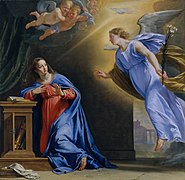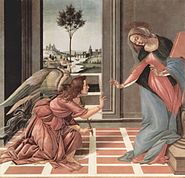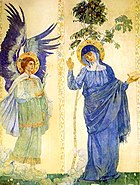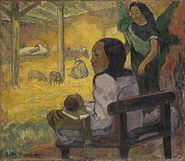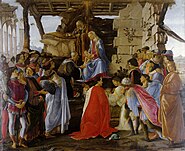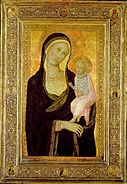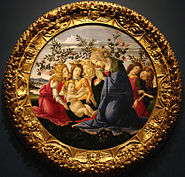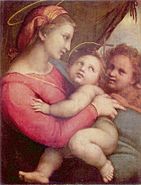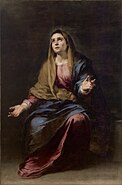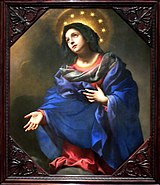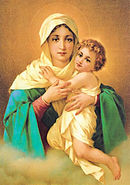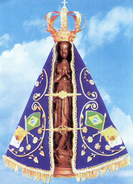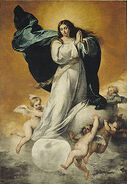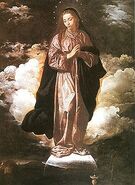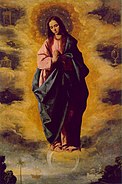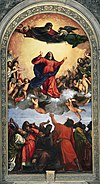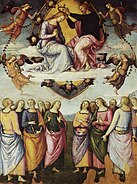
Our Mother of Perpetual Help, an icon of the Cretan school, in Rome since the 15th century, which has long been a very popular image for Catholics. Reproductions are sometimes displayed in homes or elsewhere. Archangels Michael and Gabriel are also depicted.
The Blessed Virgin Mary has been one of the major subjects of Christian Art, Catholic Art and Western Art for many centuries. Literally hundreds of thousands of pieces of Marian art in the Catholic Church covering a range of Marian artistic topics have been produced, from masters such as Michelangelo and Botticelli to humble peasant artists.[1]
Although Marian art items may at times be viewed from an artistic perspective and sold at auctions, or discussed from an academic viewpoint in the context of art history, from a religious viewpoint they form part of the very fabric of Roman Catholic Marian culture through their emotional impact on the veneration of the Blessed Virgin. The study of Mary via the field of Mariology is thus inherently intertwined with Marian art.[2]
The body of teachings that constitute Roman Catholic Mariology consist of four basic Marian dogmas: Perpetual virginity, Mother of God, Immaculate conception and Assumption into Heaven, derived from Biblical scripture, the writings of the Church Fathers, and the traditions of the Church. Other influences on Marian art have been the Feast days of the Church, Marian apparitions, writings of the saints and popular devotions such as the rosary, the Stations of the Cross, or total consecration, and also papal initiatives, and Marian papal encyclicals and Apostolic Letters.
Each of these fundamental Mariological beliefs has given rise to Roman Catholic Marian art that has become part of Mariology, by emphasizing Marian veneration, being celebrated in specific Marian feasts, or becoming part of key Roman Catholic Marian churches. This article's focus is primarily on how the artistic component of Roman Catholic Mariology has represented the fundamental Marian doctrines of the Catholic Church, and has thus interacted with them, creating a force that has shaped Catholic Mariology over the centuries.
|
General articles |
|
Expressions of devotion |
|
Specific articles |
Blending of art and theology[]

Salus Populi Romani, a popular icon in Rome.
Roman Catholic Mariology does not simply consist of a set of theological writings, but also relies on the emotional impact of art, music and architecture. Marian music and Marian shrines interact with Marian art as key components of Mariology, e.g. the construction of major Marian churches gives rise to major pieces of art for the decoration of the church.[3][4][5][6]
A good example of the interaction of Marian art, culture and churches is Salus Populi Romani, a key Marian icon in Rome at Santa Maria Maggiore, the earliest Marian church in Rome. In 1899 Eugenio Pacelli (later Pope Pius XII) said his first Holy Mass in front of it at the Santa Maria Maggiore. Fifty years later, he physically crowned this picture as part of the first Marian year in Church history, as he proclaimed the Queenship of Mary. The image was carried from Santa Maria Maggiore around Rome as part of the celebration of the Marian year and the proclamation of the Queenship of Mary.
Another example, is Our Mother of Perpetual Help. Catholics have, for centuries, prayed before this icon, usually in reproductions, to intercede on their behalf to Christ. Over the centuries, several churches dedicated to Our Mother of Perpetual Help have been constructed. In the Philippines, many Catholic churches hold a Novena and Mass honoring Our Mother of Perpetual Help every Wednesday using a replica of the icon. As recently as 1992, the song The Lady Who Wears Blue and Gold was composed in California and then performed at St. Alphonsus Liguori Church in Rome, where the icon resides. This illustrates how a medieval work of art can give rise to feast days, Cathedrals and Marian music.
In his apostolic letter Archicoenobium Casinense in 1913, Pope St. Pius X echoed the same sentiment regarding the blending of art, music and religion by comparing the artistic efforts of the Benedictine monks of the Beuron Art School (who had previously produced the “Life of the Virgin” series), to the revival of the Gregorian chant by the Benedictines of Solesmes Abbey and wrote, “...together with sacred music, this art proves itself to be a powerful aid to the liturgy”.[7]
The diversity of Marian art[]
Statue of Our Lady of San Juan de los Lagos
Roman Catholic Marian art has expressed a wide range of theological topics that relate to Mary, often in ways that are far from obvious, and whose meaning can only be recovered by detailed scholarly analysis. Entire books have been written on topics such as Our Lady of Sorrows, Black Madonna of Częstochowa, Golden Madonna of Essen, Our Lady of San Juan de los Lagos, Virgin of Mercy, Virgin of Ocotlán, Madonna and Child with Flowers, the Hortus conclusus, or the significance of fountains in Marian art and their doctrinal implications.[8][9]
Some of the leading Marian subjects include:
|
|
Early veneration[]

The Earliest fresco of the Virgin Mary, in the Catacomb of Priscilla from the middle of the second century
Early veneration of Mary is documented in the Catacombs of Rome. In the catacombs paintings show the Blessed Virgin with her son. More unusual and indicating the burial ground of Saint Peter, was the fact that excavations in the crypt of Saint Peter discovered a very early fresco of Mary together with Saint Peter[10] The Roman Priscilla catacombs depict the oldest Marian paintings from the middle of the second century [11] Mary is shown with a child on her lap, a standing man with a tunic, in his left hand is a book, in the right hand is a star over his head as a symbol of the messiah. Priscilla also has a medallion of the Annunciation.
After the Edict of Milan in 313 Christians were permitted to worship and build churches openly. The veneration of Mary became public and Marian art flourished. Some of the earliest Marian churches in Rome date to the 5th century, such as Santa Maria in Trastevere, Santa Maria Antiqua and Santa Maria Maggiore. These churches were in turn decorated with significant works of art through the centuries. The interaction of Marian art and church construction thus influenced the development of Marian art.[12]
The Virgin Mary has since become a major subject of Western Art. Masters such as Michelangelo, Botticelli, Leonardo da Vinci, Giotto, Duccio and others produced masterpieces with Marian themes.
Mother of God[]

Icon of the enthroned Virgin and Child with saints George, Theodore and angels, 6th century, Saint Catherine's Monastery, Mount Sinai.
Mary's status as the Mother of God is clear in the Gospels, and the theological implications of this were defined and confirmed by the Council of Ephesus (431). Different aspects of Mary's position as mother have been the subject of a large number of works of Catholic art.
There was a great expansion of the cult of Mary after the Council of Ephesus in 431, when her status as Theotokos was confirmed; this had been a subject of some controversy until then, though mainly for reasons to do with arguments over the nature of Christ. In mosaics in Santa Maria Maggiore in Rome, dating from 432-40, just after the council, she is not yet shown with a halo, and she is also not shown in Nativity scenes at this date, though she is included in the Adoration of the Magi.
By the next century the iconic depiction of the Virgin enthroned carrying the infant Christ was established, as in the example from the only group of icons surviving from this period, at Saint Catherine's Monastery, Mount Sinai. This type of depiction, with subtly changing differences of emphasis, has remained the mainstay of depictions of Mary to the present day. The image at Mount Sinai succeeds in combining two aspects of Mary described in the Magnificat, her humility and her exaltation above other humans.
At this period the iconography of the Nativity was taking the form, centred on Mary, that it has retained up to the present day in Eastern Orthodoxy, and on which Western depictions remained based until the High Middle Ages. Other narrative scenes for Byzantine cycles on the Life of the Virgin were being evolved, relying on apocryphal sources to fill in her life before the Annunciation to Mary. By this time the political and economic collapse of the Western Roman Empire meant that the Western, Latin, church was unable to compete in the development of such sophisticated iconography, and relied heavily on Byzantine developments.
The earliest surviving image in a Western illuminated manuscript of the Madonna and Child comes from the Book of Kells of about 800 and, though magnificently decorated in the style of Insular art, the drawing of the figures can only be described as rather crude compared to Byzantine work of the period. This was in fact an unusual inclusion in a Gospel book, and images of the Virgin were slow to appear in large numbers in manuscript art until the book of hours was devised in the 13th century.
Nativity of Jesus[]

Representation of the Nativity on the Throne of Maximianus in Ravenna
The Nativity of Jesus has been a major subject of Christian art since the 4th century. It has been depicted in many different media, both pictorial and sculptural. Pictorial forms include murals, panel paintings, manuscript illuminations, stained glass windows and oil paintings. The earliest representations of the Nativity itself are very simple, just showing the infant, tightly wrapped, lying near the ground in a trough or wicker basket.
A new form of the image, which from the rare early versions seems to have been formulated in sixth-century Palestine, was to set the essential form of Eastern Orthodox images down to the present day. The setting is now a cave - or rather the specific Cave of the Nativity in Bethlehem, already underneath the Church of the Nativity, and well-established as a place of pilgrimage, with the approval of the Church.

Nativity at Night, Geertgen tot Sint Jans, c. 1490.
Western artists adopted many of the Byzantine iconographic elements, but preferred the scriptural stable to the cave, though Duccio's Byzantine-influenced Maesta version tries to have both. During the Gothic period, in the North earlier than in Italy, increasing closeness between mother and child develops, and Mary begins to hold her baby, or he looks over to her. Suckling is very unusual, but is sometimes shown.
The image in later medieval Northern Europe was often influenced by the vision of the Nativity of Saint Bridget of Sweden (1303-1373), a very popular mystic. Shortly before her death, she described a vision of the infant Jesus as lying on the ground, and emitting light himself.
From the fifteenth century onwards, the Adoration of the Magi increasingly became a more common depiction than the Nativity proper. From the sixteenth century plain Nativities with just the Holy Family, become a clear minority, although Caravaggio led a return to a more realistic treatment of the Adoration of the Shepherds.
The perpetual character of Mary's virginity, namely that she was a virgin all her life and not only at her virginal conception of Jesus Christ at the Annunciation (that she was a virgin before, during and after giving birth to him) is alluded to in some forms of Nativity art: Salome, who according to the story in the second-century Nativity of Mary[13] received physical proof that Mary remained a virgin even in giving birth to Jesus, is found in many depictions of the Nativity of Jesus in art.
Madonna[]
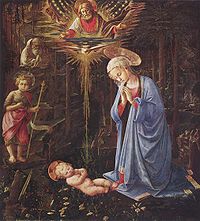
Filippo Lippi, 1459
The depiction of the Madonna has roots in ancient pictorial and sculptural traditions that informed the earliest Christian communities throughout Europe, Northern Africa and the Middle East. Important to Italian tradition are Byzantine icons, especially those created in Constantinople (Istanbul), the capital of the longest, enduring medieval civilization whose icons, such as the Hodegetria, participated in civic life and were celebrated for their miraculous properties. Western depictions remained heavily dependent on Byzantine types until at least the 13th century. In the late Middle Ages, the Cretan school, under Venetian rule, was the source of great numbers of icons exported to the West, and the artists there could adapt their style to Western iconography when required.

Romanesque enthroned Madonna, Santo Domingo de Silos Abbey
In the Romanesque period free-standing statues, typically about half life-size, of the enthroned Madonna and Child were an original Western development, since monumental sculpture was forbidden by Orthodoxy. The Golden Madonna of Essen of c. 980 is one of the earliest of these, made of gold applied to a wooden core, and still the subject of considerable local veneration, as is the 12th century Virgin of Montserrat in Catalonia, a more developed treatment.
With the growth of monumental panel painting in Italy during the twelfth and thirteenth centuries, this type was frequently painted at the image of the Madonna gains prominence outside of Rome, especially throughout Tuscany. While members of the mendicant orders of the Franciscan and Dominican Orders are some of the first to commission panels representing this subject matter, such works quickly became popular in monasteries, parish churches, and later homes. Some images of the Madonna were paid for by lay organizations called confraternities, who met to sing praises of the Virgin in chapels found within the newly reconstructed, spacious churches that were sometimes dedicated to her.
Some key Madonnas[]

Our Lady of Sorrows by Moreno, Warfhuizen, Holland.
A number of Madonna paintings and statues have gathered a following as important religious icons and noteworthy works of art in various regions of the world.
Some Madonnas are known by a general name and concept rendered or depicted by various artists. For instance, Our Lady of Sorrows is the patron saint of several countries such as Slovakia and Philippines. It is represented as the Virgin Mary wounded by seven swords in her heart, a reference to the prophecy of Simeon at the Presentation of Jesus. Our Lady of Sorrows, Queen of Poland located in the Sanctuary of Our Lady of Licheń (Poland's largest church) is an important icon in Poland. The term Our Lady of Sorrows is also used in other contexts, without a Madonna, e.g. for Our Lady of Kibeho apparitions.
Some Madonnas become the subject of widespread devotion, and the Marian shrines dedicated to them attract millions of pilgrims per year. An example is Our Lady of Aparecida in Brazil, whose shrine is surpassed in size only by Saint Peter's Basilica in Vatican City, and receives more pilgrims per year than any other Roman Catholic Marian church in the world.
South America[]
There is a rich tradition of building statues of the Madonna in South America, a sampling of which is shown in the galleries section of this article. Some noteworthy examples are:
- Our Lady of San Juan de los Lagos is located in the small town of San Juan de los Lagos in Mexico. It is the second most visited pilgrimage shrine in Mexico, after Our Lady of Guadalupe.
- The Virgin of Ocotlán is a statue of the Virgin Mary in Ocotlán, Tlaxcala, Mexico.
- Our Lady of Navigators is a highly venerated Madonna in Brazil. The devotion started by the fifteenth century Portuguese navigators, praying for a safe return to their homes and then spread in Brazil.
Italy and Spain[]
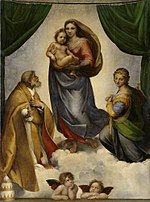
Sistine Madonna, Raphael 1513
- Raphael's Sistine Madonna painting at Saint Peter's Basilica in Rome is considered a key example of high Renaissance art.
- Madonna della Strada at the Church of the Gesu in Rome is a historic icon and the patron saint of the Jesuits
- The Madonna statue at the altar of Milan Cathedral is an outstanding example of Baroque Marian art
- Murillo's Dolorosa Madonna in Seville, Spain is a key example of a sorrowful Madonna
- Madonna of the Pillar at Zaragoza, Spain is a highly venerated statue based on a legendary vision of Saint James the Greater.
- The Virgin of Montserrat at the Santa María de Montserrat monastery in Spain is a highly venerated statue and the patron saint of Catalonia.
Central and Northern Europe[]
- The Black Madonna of Częstochowa is Poland's holiest relic, and one of the country's national symbols.
- Dutch painter Jan van Eyck's Lucca Madonna at the Städel Museum in Frankfurt is a good example of iconography where the Virgin Mary is portrayed as the Throne of Wisdom, with Jesus sitting on her lap.
- Michelangelo's statue of the Virgin Mary and a standing Jesus known as the Madonna of Bruges at the Church of Our Lady, Bruges, Belgium shares some similarities with his Pieta which was completed sometime earlier.
Mary in the Life of Christ[]

Christ and Mary, mosaic, Chora Church, 16th century
Scenes of Mary and Jesus together fall into two main groups: those with an infant Jesus, and those from the last period of his life. After the episodes of the Nativity, there are a number of further narrative scenes of Mary and the infant Jesus together which are often depicted: the Circumcision of Christ, Presentation of Jesus at the Temple, Flight into Egypt, and less specific scenes of Mary and Jesus with his cousin John the Baptist, sometimes with John's mother Elizabeth. Leonardo da Vinci's Virgin of the Rocks is a famous example. Gatherings of the whole extended family of Jesus form a subject known as the Holy Kinship, popular in the Northern Renaissance. Mary appears in the background of the only incident in the Gospels from the later childhood of Jesus, the Finding in the Temple.

Michelangelo's Pietà, 1498
Mary is then usually absent from scenes of the period of Christ's life between his Baptism and his Passion, except for the Wedding at Cana, where she is placed in the Gospels. A non-scriptural subject of Christ taking leave of his Mother (before going to Jerusalem at the start of his Passion) was often painted in 15th and early 16th century Germany. Mary is placed at the Crucifixion of Jesus by the Gospels, and is almost invariably shown, with Saint John the Evangelist, in fully depicted works, as well as often being shown in the background of earlier scenes of the Passion of Christ. The rood cross common in medieval Western churches had statues of Mary and John flanking a central crucifix. Mary is shown as present at the Deposition of Christ and his Entombment; in the late Middle Ages the Pietà emerged in Germany as a separate subject, especially in sculpture. Mary is also included, though this is not mentioned in any of the scriptural accounts, in depictions of the Ascension of Jesus. After the Ascension, she is the centrally-placed figure in depictions of Pentecost, which is her latest appearance in the Gospels.
The main scenes above, showing incidents celebrated as feast days by the church, formed part of cycles of the Life of the Virgin (though the selection of scenes in these varied considerably), as well as the Life of Christ.
Perpetual virginity[]
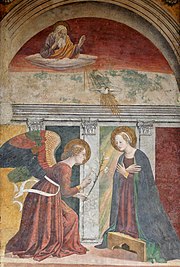
Fresco of the Annunciation at the Pantheon, Rome, 15th century
The dogma of the perpetual virginity of Mary is the earliest of the four Marian dogmas and Catholic liturgy has repeatedly referred to Mary as "ever virgin" for centuries.[17][18] The dogma means that Mary was a virgin before, during and after giving birth to Jesus Christ. The second-century work originally known as the Nativity of Mary pays special attention to Mary's virginity.[19]
This dogma is often represented in Roman Catholic art in terms of the annunciation to Mary by the Archangel Gabriel that she would conceive a child to be born the Son of God, and in Nativity scenes that include the figure of Salome.
Frescos depicting this scene have appeared in Roman Catholic Marian churches for centuries and it has been a topic addressed by many artists in multiple media, ranging from stained glass to mosaic, to relief, to sculpture to oil painting.[20]
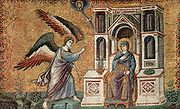
Annunciation mosaic, Santa Maria in Trastevere, Rome, 1291.
It has been one of the most frequent subjects of Christian art particularly during the Middle Ages and Renaissance. The figures of the Virgin Mary and the Archangel Gabriel, being emblematic of purity and grace, were favorite subjects of many painters such as Sandro Botticelli, Leonardo de Vinci, Caravaggio, Duccio and Murillo among others. The mosaics of Pietro Cavallini in Santa Maria in Trastevere in Rome (1291), the frescos of Giotto in the Scrovegni Chapel in Padua (1303), Domenico Ghirlandaio's fresco at the church of Santa Maria Novella in Florence (1486) and Donatello's gilded sculpture at the church of Santa Croce, Florence (1435) are famous examples.
The natural composition of the scene, consisting of two figures facing each other, also made it suitable for decorated arches above doorways.
Immaculate Conception[]
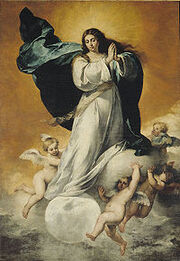
Murillo's Immaculate Conception, 1650
The dogma of the Immaculate Conception is a key example of the use of sensus fidelium shared by the faithful and the Magisterium rather than pure reliance on Scripture and tradition.[21] And depictions of the Virgin Mary on emblems and within art played a perhaps noteworthy part in building the sensus fidelium.
Given that up to the 13th century a series of saints including Bernard of Clairvaux, Bonaventure, Thomas Aquinas, and the Dominicans in general had either opposed or questioned this doctrine, Roman Catholic art on the subject mostly dates to periods after the 15th century and is absent from Renaissance art. But with support from popular opinion, the Franciscans and theologians such as Blessed Duns Scotus, the popularity of the doctrine increased and a feast-day for it was promoted.

Swiss emblem, 16th century.
The feast of the Immaculate Conception was finally established in 1476 by Pope Sixtus IV, without defining it as a dogma, which removed the possibility of controversy for artist or patron in depicting it.
In the 16th century there was a widespread intellectual fashion for emblems in both religious and secular contexts. These consisted of a visual representation of the symbol (pictura) and usually a Latin motto; frequently an explanatory epigram was added. Emblem books were very popular.[22]
Drawing on the emblem tradition, Francisco Pacheco established an iconography that influenced artists such as Murillo, Diego Velázquez and others. This style of representation of the immaculate Conception then spread to the rest of Europe, and has since remained the usual depiction.
The dogmatic definition of Immaculate Conception was performed by Pope Pius IX in his Apostolic Constitution Ineffabilis Deus, in 1854. The dogma gained additional significance from the apparitions of Our Lady of Lourdes in 1858, with the lady in the apparition identifying herself as "the Immaculate Conception" and the faithful believing her to be the Blessed Virgin Mary.
Depiction of the Immaculate Conception[]

Piero di Cosimo Immaculate Conception, 1505
From an art historical perspective, the depiction of the Immaculate Conception involves a number of interesting issues. Many artists in the 15th century faced the problem of how to depict an abstract idea such as the Immaculate Conception, and the problem was not fully solved for 150 years.
Since a key Scriptural text pointed to in support of the doctrine was "Tota pulchra es...", "Thou art all fair, my love; there is no spot in thee", verse 4.7 from the Song of Solomon,[23] a number of symbolic objects drawn from the imagery of the Song, and often already associated with the Annunciation and the Perpetual Virginity, were combined in versions of the Hortus conclusus ("enclosed garden") subject. This gave a rather cluttered subject, and usually was impossible to combine with correct perspective, so never caught on outside Germany and the Low Countries. Piero di Cosimo was among those artists who tried new solutions, but none of these became generally adopted so that the subject would be immediately recognisable to the faithful.
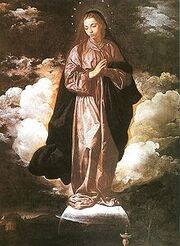
Immaculate Conception by Diego Velázquez, 1618
The definitive iconography for the Immaculate Conception, drawing on the emblem tradition, seems to have been established by the master and then father-in-law of Diego Velázquez, the painter and theorist Francisco Pacheco (1564-1644), to whom the Inquisition in Seville also contracted the approval of new images. He described his iconography in his Art of Painting (Arte de la Pintura, published posthumously in 1649):
"The version that I follow is the one that is closest to the holy revelation of the Evangelist and approved by the Catholic Church on the authority of the sacred and holy interpreters... In this loveliest of mysteries Our Lady should be painted as a beautiful young girl, 12 or 13 years old, in the flower of her youth... And thus she is praised by the Husband: tota pulchra es amica mea, a text that is always written in this painting. She should be painted wearing a white tunic and a blue mantle... She is surrounded by the sun, an oval sun of white and ochre, which sweetly blends into the sky. Rays of light emanate from her head, around which is a ring of twelve stars. An imperial crown adorns her head, without, however, hiding the stars. Under her feet is the moon. Although it is a solid globe, I take the liberty of making it transparent so that the landscape shows through."[24]
Spanish artists such as Bartolomé Murillo (especially), Diego Velázquez and others adopted this formula, with variations, and it then spread to the rest of Europe, since when it has remained the usual depiction.
This particular representation of The Immaculate Conception has since remained the best known artistic depiction of the concept: in a heavenly realm, moments after her creation, the spirit of Mary (in the form of a young woman) looks up in awe at (or bows her head to) God. The moon is under her feet and a halo of twelve stars surround her head, possibly a reference to "a woman clothed with the sun" from Revelation 12:1-2. Additional imagery may include clouds, a golden light, and cherubs. In some paintings the cherubim are holding lillies and roses, flowers often associated with Mary.
Assumption of Mary[]

Titian Assumption, 1516
The Catholic doctrine of the Assumption of Mary into Heaven states that Mary was transported into Heaven with her body and soul united. Although the Assumption was only officially declared a dogma by Pope Pius XII in his Apostolic Constitution Munificentissimus Deus in 1950, its roots in Catholic culture and art go back many centuries. While Pope Pius XII deliberately left open the question of whether Mary died before her Assumption, the more common teaching of the early Fathers is that she did.[25][26]
An early supporter of the Assumption was Saint John of Damascus (676-794), a Doctor of the Church who is often called the Doctor of the Assumption.[27] Saint John was not only interested in the Assumption, but also supported the use of holy images in response to the edict by the Byzantine Emperor Leo III, banning the worship or exhibition of holy images.[28] He wrote: "On this day the sacred and life-filled ark of the living God, she who conceived her Creator in her womb, rests in the Temple of the Lord that is not made with hands. David, her ancestor, leaps, and with him the angels lead the dance."
The Eastern Church held the feast of the Assumption as early as the second half of the sixth century, and Pope Sergius I (687-701) ordered its observance in Rome.[29]
The Orthodox tradition is clear that Mary died normally, before being bodily assumed. The Orthodox term for the death is the Dormition of the Virgin. Byzantine depictions of this were the basis for Western images, the subject being known as the Death of the Virgin in the West. As the nature of the Assumption became controversial during the High Middle Ages, the subject was often avoided, but depiction continued to be common until the Reformation. The last major Catholic depiction is Caravaggio's Death of the Virgin of 1606.
Meanwhile, depictions of the Assumption had been becoming more frequent during the late Middle Ages, with the Gothic Siennese school a particular source. By the 16th century they had become the norm, initially in Italy, and then elsewhere. They were sometimes combined with the Coronation of the Virgin, as the Trinity waited in the clouds. The subject was very suited to Baroque treatment.
Queen of Heaven[]
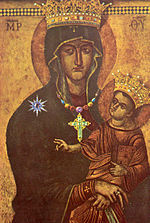
Salus Populi Romani crowned by Pope Pius XII
The Roman Catholic teaching that Mary is far above all other creatures in dignity, and after Jesus Christ possesses primacy over all goes back to the early church. Saint Sophronius said: "You have surpassed every creature" and Saint Germain of Paris (469-576) stated: "Your honor and dignity surpass the whole of creation; your greatness places you above the angels." Saint John of Damascus went further: "Limitless is the difference between God's servants and His Mother." [30][31]

Coronation of the icon by Pope Pius XII in 1954
The feast of the Queenship of Mary was only formally established in 1954 by Pope Pius XII in his encyclical Ad Caeli Reginam. Pius XII also declare the first Marian year and a number of Roman Catholic Church rededications took place, e.g. the 1955 rededication of the church of Saint James the Great in Montreal with the new title Mary, Queen of the World Cathedral a title proclaimed by Pius XII.
Yet, long before 1954 the Coronation of the Virgin had been the subject of a good number of artistic works. Some of these paintings built on the third phase of the Assumption of Mary in which following her Assumption, she is crowned as the Queen of Heaven.
Apparitions[]

Eternal Father painting the Virgin of Guadalupe. Anonymous, 18th century
Unlike most Roman Catholic theology which originates from scripture as interpreted by theologians and the upper levels of the Church, Roman Catholic Mariology has at times been driven from the ground up by religious experiences (and visions) of simple and modest individuals (in many cases children) on remote hilltops which in time have created strong emotions among large numbers of Roman Catholics. This strong response among Catholics has in turn created sensus fidelium that has influenced the higher levels of the Roman Catholic hierarchy. Examples include Saint Juan Diego in 1531 as Our Lady of Guadalupe, Saint Bernadette Soubirous as Our Lady of Lourdes in 1858 and Lucia dos Santos, Jacinta Marto and Francisco Marto as Our Lady of Fatima in 1917.[32]
As an official Vatican website Agenzia Fides wrote: "The dogma of the Immaculate Conception was defined by Pius IX not so much because of proofs in Scripture or ancient tradition, but due to a profound sensus fidelium, a century-old sense of the faithful, and the Magisterium".[33]
However, although every year over five million pilgrims visit Lourdes and Guadalupe each, the volume of Roman Catholic art to accompany this enthusiasm has been essentially restricted to popular images. Hence although apparitions have resulted in the construction of very large Marian churches at Lourdes and Guadalupe they have not so far had a similar impact on Marian art.
Galleries of Marian art[]
Perpetual virginity[]
- For a larger gallery, please see: Annunciation art
Mother of God[]
Nativity[]
Birth of Christ[]
- For more images, please see: Salome images
Adoration of the shepherds[]
- For a larger gallery, please see: Adoration of the shepherds gallery
Adoration of the Magi[]
Madonna[]
Madonna paintings[]
- For a larger gallery, please see: Madonna paintings gallery
Pre 15th century[]
15-16th century[]
Post 16th century[]
Madonna frescoes[]
- For a larger gallery, please see: Madonna frescoe gallery
Madonna statues[]
- For a larger gallery, please see: Madonna statues gallery
Mary in the Life of Christ[]
Immaculate conception[]
- For a larger gallery, please see: Immaculate conception gallery
Assumption into Heaven[]
- For a larger gallery, please see: Assumption of the Virgin Mary in art
Queen of Heaven[]
- For a larger gallery, please see: Queen of Heaven gallery
Apparitions[]
See also[]
- Art in Roman Catholicism
- Roman Catholic Marian churches
- Category:Marian shrines
References[]
- Arnold Hauser, Mannerism: The Crisis of the Renaissance and the Origins of Modern Art, Cambridge: Harvard University Press, 1965, ISBN 0674548159
- Levey, Michael (1961). From Giotto to Cézanne. Thames and Hudson,. ISBN 0-500-20024-6.
- Beckwith, John (1969). Early Medieval Art. Thames and Hudson. ISBN 0-500-20019-x.
- Rice, David Talbot (1997). Art of the Byzantine Era. Thames and Hudson. ISBN 0-500-20004-1.
- Myers, Bernard (1965, 1985). Landmarks of Western Art. Hamlyn. ISBN 0-600-35840-2.
Notes[]
- ↑ Timothy Verdon, 2006, Mary in Western Art ISBN 978-0971298194
- ↑ Caroline Ebertshauser et al. 1998 Mary: Art, Culture, and Religion through the Ages ISBN 978-0824517601
- ↑ Janusz Rosikon, 2001, The Madonnas of Europe: Pilgrimages to the Great Marian Shrines ISBN 978-0898708493
- ↑ Edel 2006, Madonna: Sacred Art And Holy Music ISBN 978-393740640
- ↑ University of Dayton Marian Music http://campus.udayton.edu/mary/marymusic.html
- ↑ Peter Mullen Shrines of Our Lady ISBN 978-0312195038
- ↑ Acta Apostolicae Sedis 5, 1913, pp.113-17
- ↑ University of Dayton http://campus.udayton.edu/mary/resources/aoeu.htm
- ↑ University of Dayron http://campus.udayton.edu/mary/resources/themeaning.htm
- ↑ M Guarducci Maria nelle epigrafi paleocristiane di Roma 1963, 248
- ↑ I Daoust, Marie dans les catacombes 1983
- ↑ Michael Rose, 2004, In Tiers of Glory: The Organic Development of Catholic Church Architecture through the Ages ISBN
- ↑ Infancy Gospel of James, chapter 20
- ↑ Schoenstatt website http://www.schoenstatt.de/index_english.htm
- ↑ Research on Luigi Crosio
- ↑ University of Dayton
- ↑ Marian Dogmas at University of Dayton http://campus.udayton.edu/mary/mariandogmas.html
- ↑ Divine Liturgy of St John Chrysostom, Coptic Liturgy of St Basil, Liturgy of St Cyril, Liturgy of St James, Understanding the Orthodox Liturgy, etc.
- ↑ L. Gambero, Mary and the Fathers of the Church trans. T. Buffer (San Francisco: Ignatius, 1991), p. 35.
- ↑ Annunciation Art, Phaidon Press, 2004, ISBN 0714844470
- ↑ Agenzia Fides - Congregazione per l'Evangelizzazione dei Popoli
- ↑ Emblems for Immaculate Conception http://campus.udayton.edu/mary/meditations/immac_con_images.html
- ↑ The whole text
- ↑ Translation from Idle Speculations
- ↑ As the Virgin Mary remained an ever-virgin and sinless, it is viewed that the Virgin Mary could not thus suffer the consequences of Original Sin, which is chiefly Death. http://www.newadvent.org/fathers/3819.htm Nicea II Session 6 Decree
- ↑ http://www.ewtn.com/library/COUNCILS/NICAEA2.HTM#2 Nicaea II Definition, "without blemish"
- ↑ Christopher Rengers, The 33 Doctors Of The Church, Tan Books & Publishers, 200, ISBN 0895554402
- ↑ Mary H. Allies, St. John Damascene on Holy Images, Followed by Three Sermons on the Assumption London, 1899.
- ↑ University of Dayton http://campus.udayton.edu/mary/resources/maryassump1.html
- ↑ Dictionary of Mary, Catholic Book Publishing Co., New York, 1985
- ↑ Ad Caeli Reginam 40
- ↑ Michael Freze, 1993, Voices, Visions, and Apparitions, OSV Publishing ISBN 087973454X
- ↑ Agenzia Fides Article
External links[]
- Christian Iconography from Augusta State University – see under Virgin Mary, after alphabet of saints
- University of Dayton: About Mary http://campus.udayton.edu/mary
| |||||||||||||||||||||||||||||||||
id:Seni rupa Bunda Maria dalam agama Katolik Roma ru:Католическая иконография Богородицы



